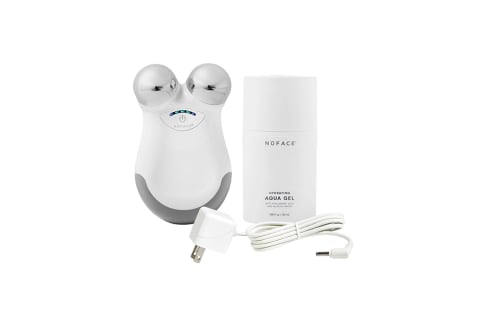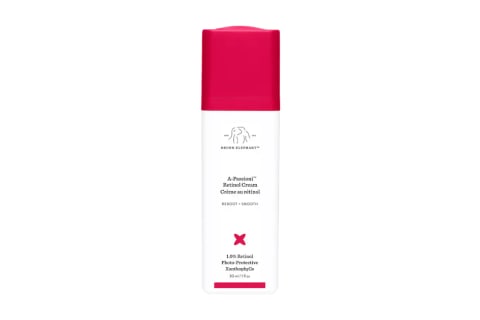We asked experts for the best noninvasive remedies to tighten sagging skin on the face. To follow, their professional advice and what causes loose skin in the first place. Let’s get into it. As you age, your face may slowly lose volume around the bones of the cheek, forehead, temples, and jawline. “This is our infrastructure, or scaffolding, that holds up the fat, collagen, and skin,” Kobets says. “When this diminishes, it causes hollowness of cheeks, under-eye, and temples but also the lower part of the face begins to sag and droop in the jowls or marionette lines,” she explains. The latter marionette lines refer to the vertical lines around the mouth. As you begin to age, sagging skin is inevitable, board-certified dermatologist and founder of MMSkincare Ellen Marmur, M.D., tells mbg. “But other factors such as diet, sun exposure, and sleep deprivation can contribute to it,” she adds. All of this to say: Aging skin is a natural process that cannot (nor should) be avoided. However, there are external factors that contribute to accelerated skin aging. What’s more, these factors like lack of sleep, smoking, chronic stress, etc., aren’t good for the health of your skin or your body. So, keep these in mind whether you’ve begun to notice sagging skin or not: “What that means is our brains use currents to communicate through our neurological pathways, where it’s constantly sending signals. What we’re doing with this technology is mimicking those currents and delivering them to our facial muscles,” she added. Essentially, microcurrent tools work through the production of adenosine triphosphate (ATP), or a molecule that’s naturally produced in the body and acts as an energy currency. Your body (skin and muscles included) uses it as part of its regenerative process, creating more collagen, elastin, etc. What’s more, these tools help strengthen the facial muscles under the skin. This, in turn, will help improve facial contour and skin tone and reduce wrinkles. “Microcurrent devices can be highly effective,” Marmur says, but only when used consistently. So pick up a microcurrent tool and make it part of your daily routine—here’s our curated list of the six best options on the market right now. One way to boost your natural collagen production is through collagen supplementation. However, not all supplements are created equal. “While there may be some truth to collagen supplements stimulating collagen production, it’s important to not skimp on quality when buying collagen supplements,” Graf emphasizes. She recommends looking for hydrolyzed collagen peptides. While collagen research may be somewhat new, most of the promising results have been seen with this form of collagen supplement. More specifically, the research shows that these collagen peptides are able to support skin elasticity and dermal collagen density1. What’s more, “Amino acids in collagen supplements might increase hydration levels in the skin,” Graf adds. Here’s a list of the very best collagen supplements, all backed by a nutrition Ph.D. if you want to start looking. One study showed that facial rolling—which lends a similar effect to gua sha—for only five minutes a day improved blood flow to the face2, resulting in better skin quality and smoother skin over time. In another, patients claimed feeling tighter, more supple skin2 after regular massages. However, gua sha is not a one-and-done kind of practice—you must be consistent to see results. Plus, using this tool is not necessarily intuitive, so you should take a few minutes to learn how to use your gua sha before touching it to the skin. For a quick breakdown of best practices and to learn more about why gua sha works, check out this story. “This ultimately leads to the triggering of our body’s wound-healing process and the release of growth factors that stimulate cell regeneration and the production of collagen and elastin,” board-certified dermatologist Michelle Henry, M.D., FAAD, once told mbg. As you now know, triggering collagen and elastin production is the goal when it comes to rejuvenating the skin and making it more taut. Kobets notes that microneedling is another worthy investment for skin tightening—however, it should be done by a professional, not at home. DIY-style dermarollers can be dangerous and difficult to use correctly. Plus, you’ll see greater results when you visit a professional for this treatment, as their needles pierce deeper into the skin. Not to mention, in-office microneedling tools are often used in conjunction with other methods like LED light therapy (more on that in a bit)—this means you’ll get even more benefits like improvement in tone, texture, etc. This effect was observed in a small human study, where retinol treatment stimulated collagen production3 in mature skin, helping decrease the appearance of wrinkling. Retinol comes in many forms, with over-the-counter and prescription-grade products available. Depending on your unique skin type and goals, you may be a candidate for stronger prescription products, but you’ll have to consult your dermatologist first. If you want to start using retinol ASAP, opt for one of these expert-approved retinol serums and use it in conjunction with a hydrating routine to prevent dryness and irritation. You may even opt for the skin cycling method, using retinol every few days—you can read all about that here. In fact, one study found that patients receiving red light therapy on their face twice a week for 30 total sessions experienced improved skin complexion4, skin tone, skin smoothness, and collagen density (as measured with an ultrasonographic test). In fact, the study included some before-and-after pictures4, which are pretty impressive. A possible explanation for the role of red light therapy on collagen production is because of the photobiomodulation mechanism. “This means that the light stimulates different pathways in cells that can trigger different outcomes,” Ilyas explained. Kobets agrees, stating that there is “robust science-based evidence for the LED devices that incorporate red light and infrared to stimulate collagen in the convenience of your own home.” However, you’ll want to do your own research to find a trustworthy device—here are a few A+ options to get you started. Losing sleep increases cortisol (the stress hormone), which can break down collagen over time—research has demonstrated a link between shut-eye and collagen production5, which is why many experts consider sleep a vital part of any “anti-aging” skin routine. So do your best to get a full seven to nine hours of sleep when you can. If you need some tips to fall asleep faster and get better quality sleep, this guide is for you. Plus, check out our favorite natural sleep aids.






